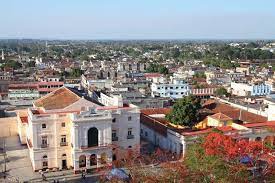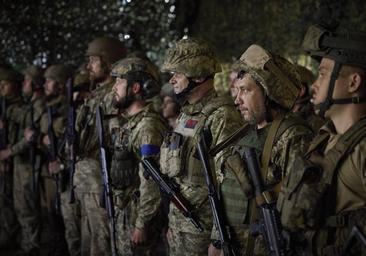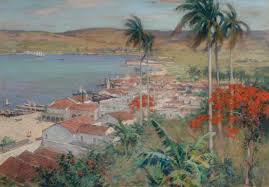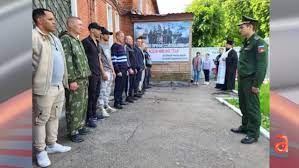EL EJERCITO CUBANO EXHIBE SU ARSENAL SUBTERRANEO Y SUS “KATIUSHAS” EN LA TV RUSA. PHOTOS.
El programa Aceptación Militar, conducido por Alexey Egorov y especializado en análisis bélico, dedicó 40 minutos a recorrer varias instalaciones de las Fuerzas Armadas.El Ejército cubano exhibe su arsenal subterráneo y sus ‘katiushas’ en la televisión rusa.

Las imágenes publicadas por Egorov salen a la luz en un contexto diplomático en el que La Habana debe pisar con pie de plomo. (Zvezda/Captura)
TANQUES de guerra, lanzamisiles, camiones Ural-4320, soldados capaces de caminar sobre alambre de púas y un laberinto de túneles secretos. Las inquietantes imágenes que el Ejército cubano permitió grabar a un reportero del canal ruso Zvezda tienen todos los ingredientes de un coctel de propaganda, pero ofrecen un mensaje claro: Cuba no tiene complejos en mostrarse ante sus aliados como un punto militar clave en la región.
El programa Aceptación Militar, conducido por Alexey Egorov y especializado en análisis de material bélico, dedicó 40 minutos a recorrer varias instalaciones de las Fuerzas Armadas, incluyendo la Academia Naval Granma, el Museo de la Revolución de La Habana y un arsenal subterráneo de más de 100 metros de profundidad.
Egorov se jactó de que en su incursión en los túneles del Ejército cubano logró “imágenes únicas”, y que su equipo es “el primer medio de comunicación extranjero en descender a los almacenes de armas” de la Isla. Mientras examinaba los lanzacohetes –conocidos popularmente como katiushas–, capacitados para disparar simultáneamente 40 proyectiles, el reportero subrayó que Cuba estaba a solo 180 kilómetros de la costa de Estados Unidos, aunque, admitió, la separan más de 9.700 kilómetros de Rusia.
La intención del programa –que contará con una segunda parte– es mostrar “cómo se endurece el acero caribeño” y “de dónde sacan su experiencia de combate los guerreros de la Isla”. Además, dedica numerosos comentarios a describir “cómo la Unión Soviética protegió a la Isla de la Libertad, con su escudo nuclear, de los ataques estadounidenses”, en alusión a los misiles con ojivas atómicas que la URSS instaló y retiró rápidamente en la Isla a inicios de la década de los 60.
Alexey Egorov, el periodista ruso al que el Ejército abrió las puertas de sus instalaciones, es un incondicional de Vladímir Putin y un entusiasta defensor de su invasión a Ucrania. A prueba de balas en materia ideológica, Egorov figura en la lista de 1.500 belicistas al servicio del Kremlin publicada por el Foro Rusia Libre.
Los anfitriones no escatimaron atenciones al enviado de Moscú. Con una lámpara en la mano y tras entregar su teléfono celular, Egorov comenzó su programa elogiando las instalaciones militares cubanas y atravesando varios metros de túneles en excelente estado, bien iluminados y señalizados. Lo acompañaba en todo momento, aunque no fueron identificados, un primer coronel de las Fuerzas Armadas y varios coroneles en traje de campaña.
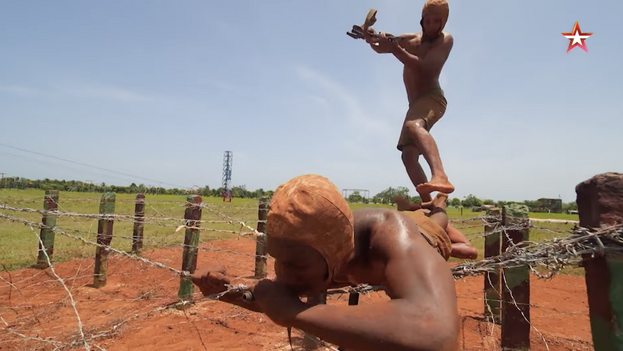
Además de ejercicios físicos, estudios tácticos y combates cuerpo a cuerpo, los reclutas deben caminar descalzos y sin camisa sobre alambres de púas. (Zvezda/Captura)
Cubiertos con lonas, para protegerlos de la humedad, había varios tanques de guerra, camiones rusos Ural y chinos Howo, que ya el Ejército había exhibido durante desfiles a inicios de año. También visitó el llamado Grupo Reactivo de Artillería, donde se guardan los lanzamisiles, instalados sobre vehículos Ural, y varios implementos de la logística y alimentación del Ejército.
Egorov comparó los túneles cubanos con los de Corea del Norte, que también visitó durante una emisión de su programa. El sistema de entrenamiento y de protección del arsenal, demostró, son muy similares, y las tropas de la Isla han probado su efectividad en operaciones en Angola, Etiopía y Granada, enumeró, aunque se sabe que los soldados cubanos huyeron en desbandada ante la 82 División Aerotransportada de EE UU en Granada.
La cámara se traslada luego a campo abierto, donde varios pelotones de Avispas Negras –armados con fusiles kaláshnikov y con pintura de camuflaje– muestran sus maniobras de entrenamiento junto a la costa. Además de ejercicios físicos, estudios tácticos y combates cuerpo a cuerpo, los reclutas deben caminar descalzos y sin camisa sobre alambres de púas. Otra de las operaciones consiste en acostarse sobre los cordeles para que otros soldados caminen sobre su espalda.
En la Academia Naval Granma, al este de La Habana, Egorov examinó las técnicas de entrenamiento de la Marina cubana. Entre sus equipos, el reportero destacó un simulador virtual que ocupa toda una sala, y que reproduce el puente de un buque de guerra. Las imágenes de entrenamiento son las de una hipotética batalla en la bahía habanera.
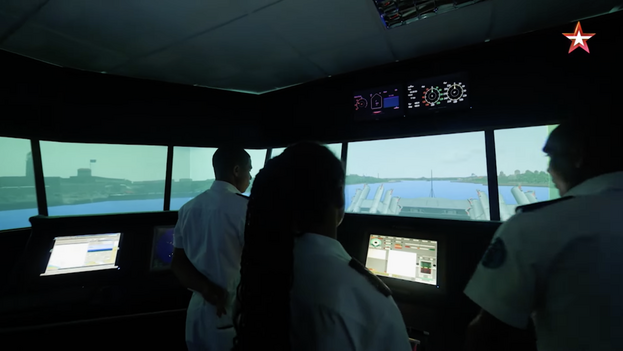
El reportero destacó un simulador virtual que ocupa toda una sala, y que reproduce el puente de un buque de guerra. (Zvezda/Captura)
Para ilustrar la excelente salud entre los altos cargos militares de Rusia y Cuba, Egorov mostró grabaciones de la reunión en Moscú entre el ministro cubano de las Fuerzas Armadas, Álvaro López Miera, y su homólogo ruso, Serguéi Shoigú, el pasado junio. El periodista también enseñó imágenes inéditas de la visita a La Habana del buque-escuela ruso Perekop –cuyas autoridades cancelaron, sin explicación, las visitas que los civiles cubanos tenían programadas a su cubierta, el pasado julio– y su recorrido por el Museo de la Revolución y el de Playa Girón.
Las imágenes publicadas por Egorov salen a la luz en un contexto diplomático en el que La Habana debe pisar con pies de plomo. Por un lado, el reciente anuncio de que el régimen planea comprar a Bielorrusia misiles Polonez-M, con un alcance de 300 metros sería una provocación militar directa para la región. Por otro, la ratificación de Cuba como uno de los países patrocinadores del terrorismo, según la lista anual que elabora Estados Unidos.
Todo, tras un año de máxima tensión en el que los rumores sobre bases de espionaje rusas en la Isla, la presencia de soldados cubanos en la invasión a Ucrania y la alianza entre La Habana y el Kremlin, ha llenado las primeras planas de todos los periódicos del mundo, menos los de Cuba.
THE CUBAN ARMY DISPLAYS ITS UNDERGROUND ARSENAL AND ITS “KATIUSHAS” ON RUSSIAN TV. PHOTOS.
The Military Acceptance program, hosted by Alexey Egorov and specialized in war analysis, dedicated 40 minutes to tour various facilities of the Armed Forces. The Cuban Army exhibits its underground arsenal and its ‘katiushas’ on Russian television.
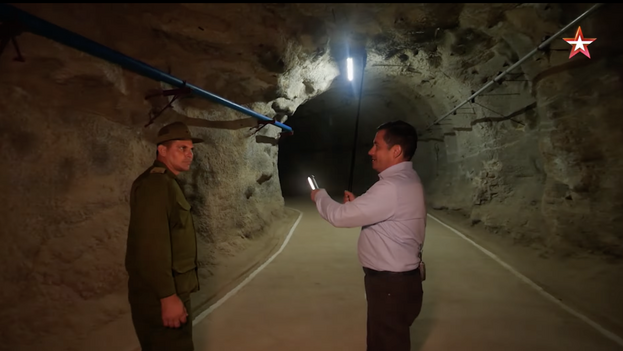
Egorov boasted that in his raid into the Cuban Army tunnels he achieved “unique images.” (Zvezda/Capture)
War TANKS, missile launchers, Ural-4320 trucks, soldiers capable of walking on barbed wire and a labyrinth of secret tunnels. The disturbing images that the Cuban Army allowed a reporter from the Russian channel Zvezda to record have all the ingredients of a propaganda cocktail, but they offer a clear message: Cuba has no complexes in showing itself to its allies as a key military point in the region.
The Military Acceptance program, led by Alexey Egorov and specialized in analysis of war material, dedicated 40 minutes to tour various facilities of the Armed Forces, including the Granma Naval Academy, the Museum of the Revolution in Havana and an underground arsenal of more than 100 meters deep.
Egorov boasted that in his foray into the Cuban Army tunnels he achieved “unique images,” and that his team is “the first foreign media outlet to descend into the weapons warehouses” on the island. While examining the rocket launchers – known popularly called katiushas –, capable of firing 40 projectiles simultaneously, the reporter stressed that Cuba was only 180 kilometers from the coast of the United States, although, he admitted, more than 9,700 kilometers separated it from Russia.
The intention of the program – which will have a second part – is to show “how Caribbean steel is hardened” and “where the island’s warriors get their combat experience.” In addition, he devotes numerous comments to describing “how the Soviet Union protected Liberty Island, with its nuclear shield, from American attacks,” alluding to the missiles with atomic warheads that the USSR quickly installed and removed on the Island at beginning of the 60’s.
Alexey Egorov, the Russian journalist to whom the Army opened the doors of its facilities, is a staunch supporter of Vladimir Putin and an enthusiastic defender of his invasion of Ukraine. Bulletproof in ideological matters, Egorov appears on the list of 1,500 warmongers in the service of the Kremlin published by the Free Russia Forum.
The hosts spared no attention to the Moscow envoy. With a lamp in his hand and after handing over his cell phone, Egorov began his program praising the Cuban military installations and going through several meters of tunnels in excellent condition, well lit and signposted. He was accompanied at all times, although they were not identified, by a first colonel of the Armed Forces and several colonels in field dress.
Covered with tarps to protect them from humidity, there were several war tanks, Russian Ural trucks and Chinese Howo, which the Army had already exhibited during parades at the beginning of the year. He also visited the so-called Reactive Artillery Group, where the missile launchers, installed on Ural vehicles, and various Army logistics and food implements are kept.
Egorov compared the Cuban tunnels with those in North Korea, which he also visited during a broadcast of his program. The training and protection system of the arsenal, he demonstrated, are very similar, and the island’s troops have proven their effectiveness in operations in Angola, Ethiopia and Granada, he listed, although it is known that the Cuban soldiers fled in disarray before the 82nd. US Airborne Division in Grenada.
The camera then moves to open fields, where several platoons of Black Wasps – armed with Kalashnikov rifles and wearing camouflage paint – demonstrate their training maneuvers along the coast. In addition to physical exercises, tactical studies and hand-to-hand combat, recruits must walk barefoot and shirtless over barbed wire. Another operation consists of lying on the ropes so that other soldiers walk on their backs.
At the Granma Naval Academy, east of Havana, Egorov examined the training techniques of the Cuban Navy. Among his equipment, the reporter highlighted a virtual simulator that occupies an entire room, and that reproduces the bridge of a warship. The training images are those of a hypothetical battle in Havana Bay.
To illustrate the excellent health among the senior military officials of Russia and Cuba, Egorov showed recordings of the meeting in Moscow between the Cuban Minister of the Armed Forces, Álvaro López Miera, and his Russian counterpart, Sergei Shoigu, last June. The journalist also showed unpublished images of the visit to Havana of the Russian training ship Perekop – whose authorities canceled, without explanation, the visits that Cuban civilians had scheduled to its deck, last July – and his tour of the Museum of Revolución and Playa Girón.
The images published by Egorov come to light in a diplomatic context in which Havana must tread carefully. On the one hand, the recent announcement that the regime plans to buy Polonez-M missiles from Belarus, with a range of 300 meters, would be a direct military provocation for the region. On the other hand, the ratification of Cuba as one of the countries sponsoring terrorism, according to the annual list prepared by the United States.
Everything, after a year of maximum tension in which rumors about Russian spy bases on the Island, the presence of Cuban soldiers in the invasion of Ukraine and the alliance between Havana and the Kremlin, have filled the front pages of all the newspapers. newspapers from around the world, except those from Cuba.
Agencies/ Wiki/ 14yMedio, La Habana/ Extractos/ Excerpts/ Internet Photos/ Arnoldo Varona/ www.TheCubanHistory.com
THE CUBAN HISTORY, HOLLYWOOD.













